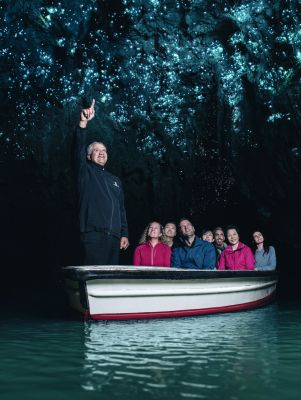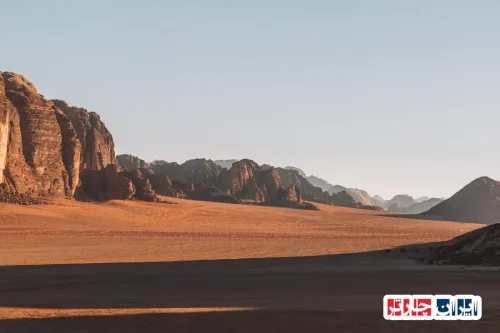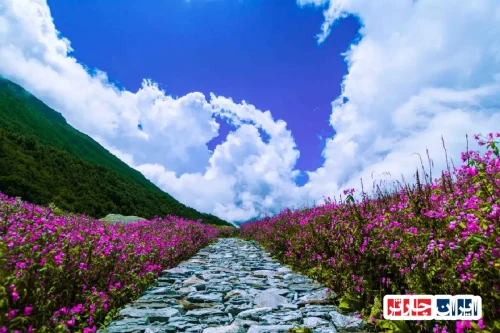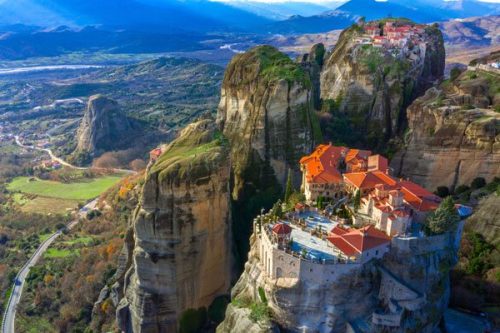Discover the Majestic Wadi Rum Desert in Aqaba Governorate Jordan
Wadi Rum Desert in Aqaba Governorate Jordan is a breathtaking natural wonder renowned for its stunning landscapes, towering sandstone mountains, and vast sandy plains. This remarkable desert, often called the Valley of the Moon, offers visitors an unparalleled experience of untouched nature and ancient history. Exploring the Wadi Rum Desert in Aqaba Governorate Jordan allows travelers to witness spectacular rock formations, deep canyons, and unique geological structures that have been shaped over millions of years. The area is also rich in cultural heritage, with numerous petroglyphs and inscriptions left by ancient civilizations. Whether you’re interested in adventure activities like rock climbing and desert safaris or seeking tranquility amidst extraordinary scenery, the Wadi Rum Desert in Aqaba Governorate Jordan provides an unforgettable destination that combines natural beauty with historical significance. For more information and booking options, visit Wadi Rum Desert-Iran Charter. Experience the magic of the Wadi Rum Desert in Aqaba Governorate Jordan and immerse yourself in one of the world’s most captivating desert landscapes, a true jewel of Jordan that promises adventure, serenity, and cultural discovery all in one place.
Discovering the Rich History and Cultural Significance of Wadi Rum Desert in Aqaba Governorate Jordan
The Wadi Rum Desert in Aqaba Governorate Jordan is a UNESCO World Heritage site renowned for its ancient history, stunning landscapes, and cultural heritage. This expansive desert has been a crossroads of civilizations for thousands of years, hosting various tribes and civilizations that have left their mark through inscriptions, architecture, and traditions. Exploring the history of Wadi Rum reveals a tapestry of human resilience and adaptation amidst the harsh desert environment.
From the earliest nomadic tribes to modern explorers, Wadi Rum has served as a vital hub for trade, cultural exchange, and spiritual practices. Archaeological findings indicate that the region was inhabited as far back as the Neolithic period, with evidence of petroglyphs, ancient dwellings, and burial sites. These relics provide insight into the lives, beliefs, and social structures of past inhabitants, making Wadi Rum a living museum of human history.
Throughout the centuries, Wadi Rum has witnessed the rise and fall of various civilizations, including the Nabataeans, Romans, and early Islamic communities. Each era contributed to the cultural fabric of the region, evident in the inscriptions, ruins, and traditional practices still preserved today. The desert’s strategic location made it a vital corridor for trade routes connecting the Arabian Peninsula with the Levant and North Africa.
The Unique Natural Landscape of Wadi Rum in Aqaba Governorate Jordan: Mountains, Valleys, and Rock Formations
The natural scenery of Wadi Rum is a breathtaking display of geological artistry, characterized by towering sandstone mountains, deep valleys, and surreal rock formations. The landscape’s dramatic features are the result of millions of years of geological activity, erosion, and tectonic movements, creating a visual spectacle that attracts travelers worldwide.
The iconic sandstone cliffs and narrow canyons offer a playground for adventure enthusiasts, with opportunities for rock climbing, hiking, and exploring hidden caves. The natural arches, pillars, and domes, such as the famous Burdah Rock Bridge, exemplify the region’s geological diversity and aesthetic appeal. These formations not only serve as natural monuments but also as habitats for unique flora and fauna adapted to desert life.
The landscape’s grandeur also influences the local climate and ecosystem, supporting a variety of plant and animal species that have adapted to survive in extreme conditions. The interplay of light and shadow across the rugged terrain creates mesmerizing vistas, especially during sunrise and sunset, making Wadi Rum a photographer’s paradise and a symbol of natural beauty in Jordan.
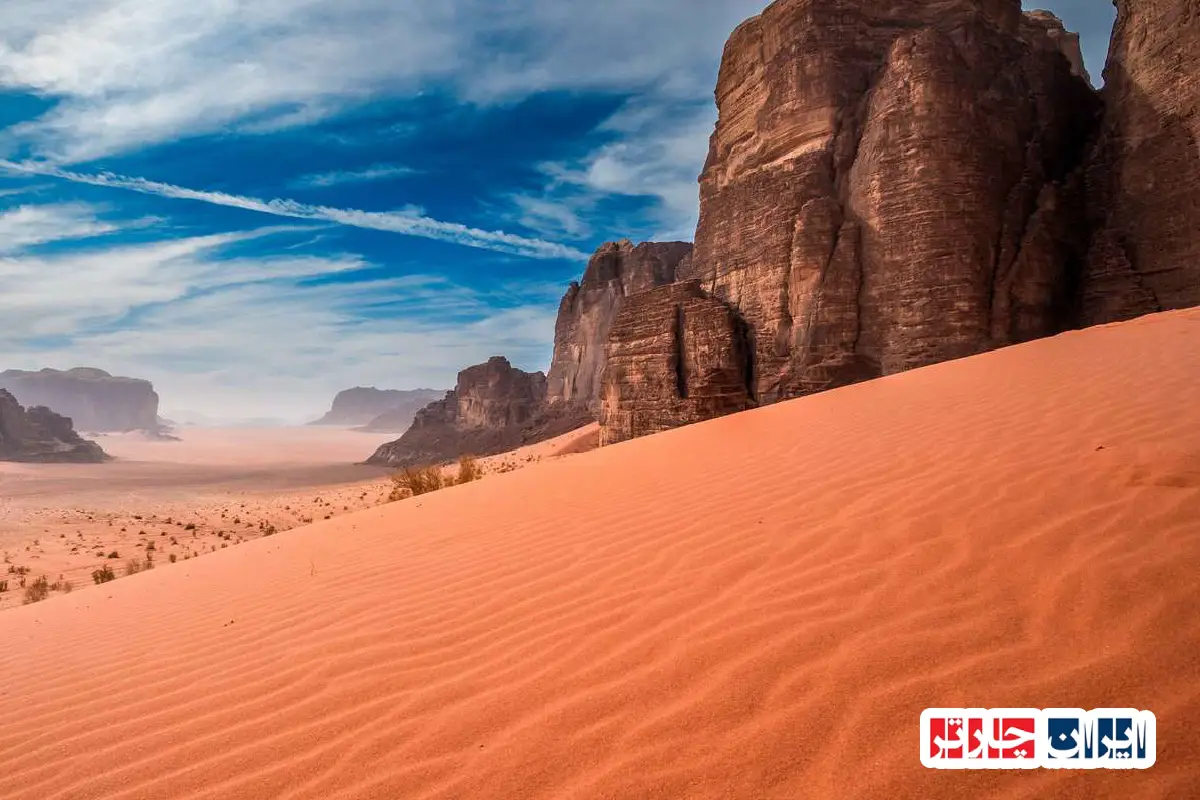
Ancient Inscriptions and Rock Art: Unlocking the Secrets of Past Civilizations in Wadi Rum
Wadi Rum is home to an extensive collection of petroglyphs, inscriptions, and carvings dating back thousands of years. These ancient artworks are invaluable records of the region’s early inhabitants, depicting scenes of hunting, religious rituals, and daily life. Studying these inscriptions helps researchers understand the development of language, culture, and social organization in the area.
Many of the carvings are attributed to the Nabataean civilization, known for their sophisticated trade networks and architectural achievements. The inscriptions often include names, symbols, and religious motifs, revealing the spiritual beliefs and cultural influences that shaped the region. Preservation of these sites is crucial for maintaining the historical integrity of Wadi Rum’s archaeological heritage.
In addition to inscriptions, rock art depicting animals, human figures, and abstract symbols provides insights into the spiritual and practical aspects of ancient life. These artworks also serve as a bridge connecting modern visitors with the ancestors who once thrived in the desert, emphasizing the importance of protecting and studying this open-air museum for future generations.
Adventure Tourism in Wadi Rum: Climbing, Trekking, and Exploring the Desert’s Hidden Gems
Wadi Rum offers a wealth of adventure activities that appeal to thrill-seekers and nature lovers alike. The rugged terrain provides ideal conditions for rock climbing, with routes suitable for beginners and experienced climbers. The towering cliffs and natural arches create a challenging yet rewarding environment for outdoor sports enthusiasts.
Hiking and trekking through the desert’s valleys and mountain ranges allow visitors to immerse themselves in the awe-inspiring landscape while discovering lesser-known sites and natural wonders. Guided tours often include visits to ancient inscriptions, traditional Bedouin camps, and scenic viewpoints that showcase the desert’s diverse beauty.
For those seeking a more immersive experience, camel rides and 4×4 safaris offer a unique way to explore the remote corners of Wadi Rum. These adventures not only provide adrenaline rushes but also foster a deeper appreciation for the desert’s ecological and cultural significance, making Wadi Rum a premier destination for adventure tourism in Jordan.
Bedouin Culture and Traditions in Wadi Rum: Living Heritage in Aqaba Governorate
The Bedouin tribes of Wadi Rum embody a rich cultural heritage that has been preserved for generations. Their traditional way of life, including hospitality, music, dance, and crafts, offers a glimpse into the resilience and adaptability of desert communities. Visitors can experience authentic Bedouin hospitality through homestays, cultural performances, and local cuisine.
Bedouin life revolves around herding, storytelling, and maintaining social bonds that are deeply rooted in the desert environment. Their customs, such as the art of hospitality and the significance of oral poetry, continue to play a vital role in community cohesion and cultural identity. These traditions also serve as a bridge for cultural exchange with travelers from around the world.
In recent years, Bedouin communities have embraced sustainable tourism initiatives, offering eco-friendly accommodations and guided tours that promote cultural preservation and economic development. Engaging with Bedouin culture enriches visitors’ understanding of the desert’s history and fosters appreciation for the indigenous peoples of Jordan’s Aqaba Governorate.
Wadi Rum in Films and Media: A Cinematic Landscape of Adventure and Mystery
The dramatic scenery of Wadi Rum has made it a popular filming location for movies, documentaries, and commercials. Its otherworldly rock formations and expansive vistas provide an ideal backdrop for storytelling, especially in genres like science fiction, adventure, and historical epics. The desert’s cinematic appeal has helped boost tourism and global recognition of Jordan’s natural beauty.
Several internationally acclaimed films have utilized Wadi Rum’s landscape to depict alien planets, ancient battlegrounds, and remote wildernesses. These productions showcase the region’s unique geology and scenic grandeur, inspiring audiences worldwide and attracting film crews seeking authentic desert settings.
Beyond cinema, Wadi Rum hosts cultural festivals, photography exhibitions, and media projects that highlight its natural and cultural assets. Its reputation as a cinematic landscape continues to grow, making it a must-visit destination for travelers interested in exploring the intersection of natural beauty and visual storytelling in Jordan.
Best Time to Visit Wadi Rum: Planning Your Trip for Optimal Experience in Aqaba Governorate
Choosing the right time to visit Wadi Rum is essential for enjoying its natural beauty and outdoor activities. The most favorable seasons are spring (March to May) and autumn (September to November), when temperatures are moderate and conducive to hiking, camping, and sightseeing. During these months, the desert’s landscape is lush with wildflowers and vibrant colors.
Summer months (June to August) can be extremely hot, with daytime temperatures soaring above 40°C, making outdoor exploration challenging. However, early mornings and evenings offer cooler conditions and spectacular sunset and sunrise views. Winter (December to February) brings cooler temperatures and occasional rain, which can enhance the scenery but may limit certain activities.
Travelers should also consider local festivals, cultural events, and religious holidays that may affect accessibility or provide unique opportunities for cultural immersion. Proper planning, including packing suitable clothing, sun protection, and hydration supplies, ensures a safe and memorable experience exploring Wadi Rum’s majestic landscapes in Aqaba Governorate.
The Impact of Climate and Environment on Wadi Rum’s Landscape and Ecosystem
The climate of Wadi Rum is characterized by extreme temperature variations, low rainfall, and high evaporation rates, shaping its distinctive desert environment. These conditions influence the formation of its unique geological features and support specialized flora and fauna adapted to survive in arid conditions.
The intense heat during summer causes rapid erosion and weathering of rocks, creating the iconic formations seen today. Wind and temperature fluctuations also contribute to the ongoing sculpting of the landscape, ensuring that Wadi Rum remains a dynamic natural sculpture gallery.
Despite the harsh environment, Wadi Rum hosts a variety of resilient plant species, such as desert shrubs and grasses, along with animals like foxes, lizards, and insects that have evolved to thrive here. Preserving this fragile ecosystem requires sustainable tourism practices and environmental awareness to maintain the desert’s natural beauty and ecological balance for future generations.
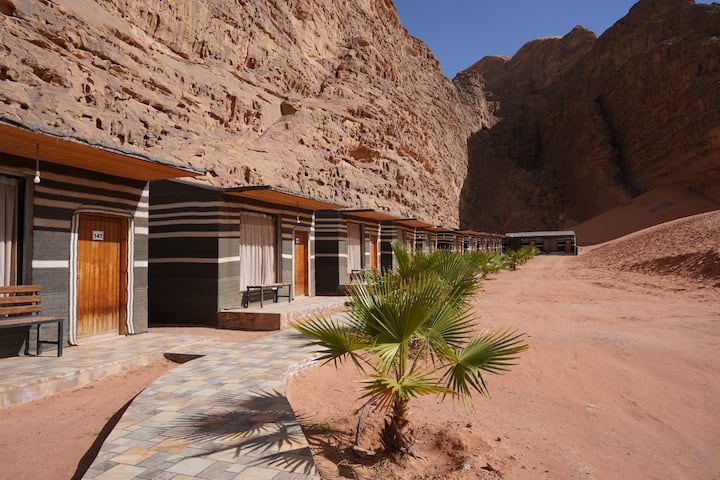
Frequently Asked Questions about Wadi Rum Desert in Aqaba Governorate, Jordan
- What is the historical significance of Wadi Rum?
- Wadi Rum has a rich history dating back to the Neolithic period, serving as a crossroads for ancient civilizations. It features petroglyphs, inscriptions, and archaeological sites that reveal the lives of early inhabitants, including nomadic tribes, the Nabataeans, Romans, and early Islamic communities. These relics highlight its importance as a cultural and trade hub over thousands of years.
- What makes the landscape of Wadi Rum unique?
- The landscape is characterized by towering sandstone mountains, deep valleys, and surreal rock formations shaped by millions of years of geological activity. Iconic features like natural arches, cliffs, and the famous Burdah Rock Bridge showcase the region’s geological diversity and natural beauty, attracting adventurers and photographers worldwide.
- How old are the petroglyphs and inscriptions found in Wadi Rum?
- The petroglyphs and inscriptions date back thousands of years, with some carvings attributed to the Nabataean civilization. These artworks depict scenes of hunting, religious rituals, and daily life, offering valuable insights into ancient cultures and spiritual beliefs.
- What activities can tourists enjoy in Wadi Rum?
- Visitors can engage in various adventure activities such as rock climbing, hiking, trekking, and exploring hidden caves. Camel rides and 4×4 safaris are popular for exploring remote areas. The region also offers opportunities for camping under the stars and discovering ancient inscriptions and natural wonders.
- How do Bedouin traditions influence Wadi Rum today?
- The Bedouin tribes preserve a rich cultural heritage through hospitality, music, dance, and crafts. Visitors can experience authentic Bedouin life via homestays, cultural performances, and local cuisine. Their customs foster cultural exchange and promote sustainable tourism in the region.
- Why is Wadi Rum a popular filming location?
- Its otherworldly landscapes with dramatic rock formations and expansive vistas make it ideal for movies and documentaries. Films depicting alien planets, ancient battles, or wilderness settings have utilized Wadi Rum’s scenery, boosting its international recognition and tourism appeal.
- When is the best time to visit Wadi Rum?
- The optimal seasons are spring (March-May) and autumn (September-November), when temperatures are moderate. Summer can be extremely hot, while winter offers cooler weather and occasional rain. Planning visits during these periods ensures a comfortable outdoor experience.
- What is the impact of climate on Wadi Rum’s landscape?
- The extreme temperatures and low rainfall shape its distinctive geological features. Erosion, wind, and temperature fluctuations continually sculpt the landscape, supporting a fragile ecosystem of specialized plants and animals adapted to desert conditions.
- Are there any environmental concerns in Wadi Rum?
- Yes, preserving Wadi Rum’s natural beauty requires sustainable tourism practices. Over-tourism can threaten its ecosystem, so efforts focus on eco-friendly accommodations, responsible exploration, and environmental awareness to protect its delicate environment for future generations.
- What types of wildlife can be found in Wadi Rum?
- The desert hosts resilient species such as foxes, lizards, insects, and various plant varieties like desert shrubs and grasses. These species have adapted to survive in harsh conditions, making Wadi Rum a unique habitat for desert flora and fauna.
- How do the natural formations in Wadi Rum benefit tourism?
- Natural arches, cliffs, and rock bridges like Burdah provide scenic spots for climbing, photography, and exploration. These formations also serve as natural landmarks, enhancing the region’s appeal for outdoor activities and adventure tourism.
- Can visitors explore Wadi Rum independently?
- While independent exploration is possible, guided tours are recommended to ensure safety, access to hidden sites, and a richer understanding of the region’s history and culture. Local guides also promote sustainable tourism and support the community.
- What cultural experiences are available in Wadi Rum?
- Tourists can participate in Bedouin hospitality, enjoy traditional music and dance, and learn about local crafts. Cultural festivals and storytelling sessions offer deeper insights into Bedouin life and heritage.
- How has Wadi Rum influenced media and popular culture?
- The region’s striking scenery has been featured in numerous movies and media projects, portraying alien worlds or ancient landscapes. Its cinematic appeal has increased global interest and tourism, making it a symbol of natural and cinematic beauty in Jordan.
- What should travelers consider when planning a trip to Wadi Rum?
- Plan visits during spring or autumn for optimal weather. Pack suitable clothing, sun protection, and sufficient water. Book guided tours if unfamiliar with the area. Respect local customs and preserve the environment to enjoy a safe and meaningful experience.











